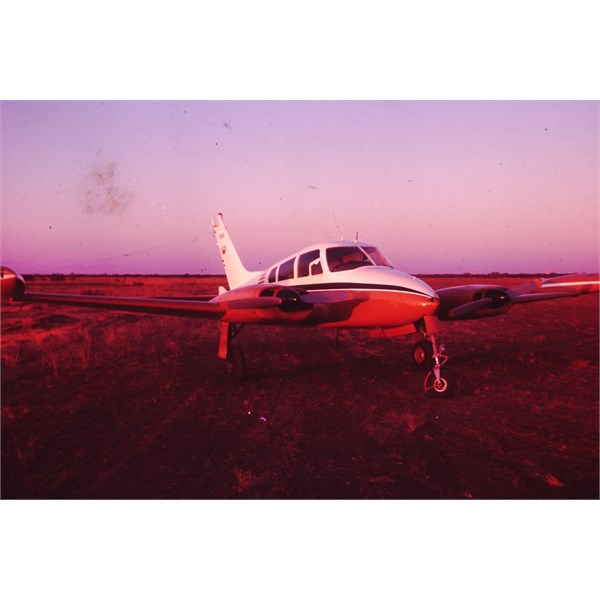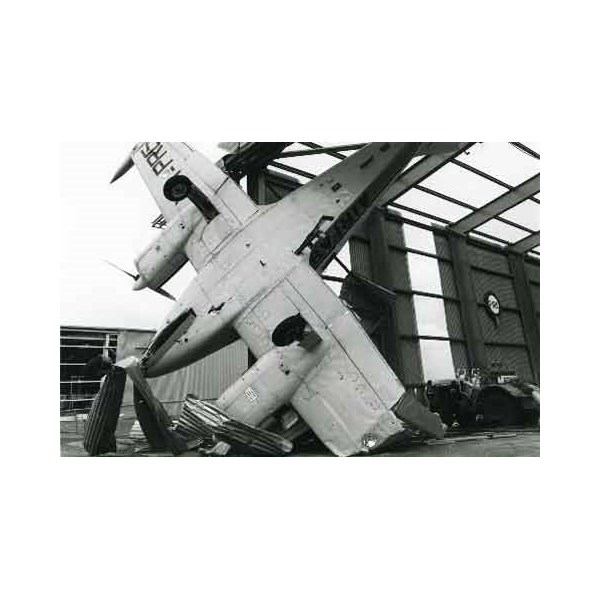Sunday, Jun 22, 2014 at 00:53
Here's an interesting aviation crash picture with a long story behind it.
(Photo copyright Tony Burgess)
A dissatisfied European migrant in
Perth in 1962, decided he was homesick, and the best and quickest way
home, was to fly.
However, his flying plans didn't involve an air ticket - it involved stealing an aircraft to fly
home to Europe.
He took a few flying lessons in a Cessna - enough to learn how to basically fly - and then hatched a plan to steal a Cessna.
A Cessna 175C, registration VH-RDT, was a Rex Aviation demonstrator, and it was stored at Maylands Aerodrome,
Perth, W.A..
Left unlocked and easily accessible, it was stolen by the migrant from a hangar at Maylands Aerodrome on 24 July 1962.
The migrant made it to the far North of W.A., but ran out of fuel and made a forced landing, 160
miles SE of Ethel Creek Station.
The nosewheel of the Cessna was torn off in the landing on sandhill country.
A large search failed to locate the aircraft until the migrant walked into Ethel Creek Station eight days later.
The Cessna was then located by retracing his route.
The engine, prop and instruments were removed and the aircraft declared an insurance writeoff.
VH-RDT was struck off the Aircraft Register in October 1962.
The remains of the aircraft were then salvaged by Max & Jim Hazelton of
Orange NSW.
They utilised an International ASW-160 truck, which they drove from
Orange to Ethel Creek Station.
I don't know the route they took, but it sure would have been some trip in late 1962/early 1963.
The old Inter would have gutsed some fuel on a trip like that, as
well - not to mention the top speed - which would have been around 75kmh loaded and an absolute best of 80kmh empty.
No truck was allowed to exceed 80kmh in this era, so they were all built, geared to 80kmh maximum speed.
The truck is interesting, in that it's fitted with single wheels all round.
I've only ever seen duals on the rear of the civilian International 4WD trucks of this era.
I'm not sure how the rear axle was modified - it must have been replaced with a wider one to give equal track front and rear.
The wings and tailplane of the Cessna were unbolted, and strapped underneath the fuselage - which was lifted onto the truck and strapped down facing rearwards.
There would have been little weight in the stripped fuselage, it would have been easily lifted on by 3 men.
The ASW-160 Inter truck then made its long return trip with the Cessna fuselage, to
Orange, NSW, to commence a rebuild of the aircraft.
VH-RDT was fully rebuilt by the Hazeltons, returning to the Register as VH-SEA in July 1963.
It was rebuilt as a Cessna 172C, when its original 175HP Continental GO-300-E engine was replaced with a less-powerful 145HP Continental O-300-C engine, by the Hazeltons.
After its rebuild, VH-SEA was sold to Messrs J.W. Smith & E.A Wade of Birchip, Vic - and the new registration was selected by using a combination of the new owners initials.
Amazingly, VH-SEA is still fully operational and still flying, as the sites below show.
This aircraft is now over 52 years old.
The migrant was arrested and charged with the theft of the aircraft and received a jail sentence. I'm led to believe, after serving his sentence, he was deported.
Cessna 172C - VH-SEACessna VH-SEA, Parafield 2013
AnswerID:
534772
Follow Up By: Bob Y. - Qld - Sunday, Jun 22, 2014 at 10:15
Sunday, Jun 22, 2014 at 10:15
Thanks for that one, Ron. Pretty funny...........
Ol' Mate's obviously not the sharpest tool in the shed, eh. By time he paid for some lessons, he would have spent enough to fly
home. And if you're going to pinch a plane to get somewhere, in a hurry, then you'd at least swipe a Cessna, like one above, or maybe a Baron. Certainly not something like a 172. :-)
Four of us left Mt Isa one morning, heading for Brunette Downs, in a 172. Reckon we used up most of the strip to get off the ground, even though we didn't have much luggage, and none of us were over 95kg.
After a steady run past
Camooweal, we ran into a big "Bedourie" and had to go IFR (I follow roads). Some discussion about if we should divert somewhere, but I noticed a few landmarks I recognised from working on
Avon Downs. Kept going, hit the Barkly Stock Route, and followed that safely to Brunette. It was prior to the DRCS phone system, so there were no rather tall phone towers to interact with.
Thanks,
Bob
FollowupID:
818529
Follow Up By: Mark O4 - Sunday, Jun 22, 2014 at 10:49
Sunday, Jun 22, 2014 at 10:49
Ron, I read recently that Jim Hazelton died not long ago and I have found more details of his life which is very interesting. Sad to loose another aviation pioneer.
"James David (Jim) Hazelton died on June 10 at his Turners Flat
home in northern NSW after a long battle with illness. He was 10 days short of his 83rd birthday. Family members and Jim’s wife Pam were by his side when he died.
A modest person, Jim was and one of the greatest aviators and gifted pilots this country has seen. There are few people in the aviation community that have not known of him and the many achievements and contributions he made to general aviation.
He imparted knowledge upon all who had the privilege to sit next to the master, and there were many. He was unselfish with his time and went out of his way to help others with the art of flying aircraft, often to his own detriment.
There is probably no stronger aviation name than Hazelton in Australia. Many of the Hazeltons fly aircraft and Jim’s sons both work in the sector painting aircraft.
Jim started flying at a
young age and was a founder of Hazelton Airlines, which he started with his brother Max at
Orange before leaving that business to form and develop Navair, where literally hundreds of Australian airman and women were trained.
He was a pioneer of crop dusting in Australia and then went on to ferry aircraft all over the world. Unlike many of his competitors in the ferry game, Jim never lost a plane and always completed the ferry task. He was one of the first to cross the Pacific in a single engine aircraft and had done so
well over 200 times.
In recent times Jim bought a Catalina float plane to Australia from Portugal and dropped by Port Macquarie to the entertainment of locals before going on to
Sydney. His last ferry flight was conducted just months ago.
It would be remiss not to mention Jim’s beloved wife Pam, who put up with his obsession and allowed him to be away so much following his pursuit of flying. Jim would always ring her daily to let her know of his arrival at various ports and forward plans. Meanwhile, Pam would take inquiries regarding the next possible ferry flight.
Jim was incredibly quiet about his achievements, but was known not only in Australia but all over the world. He had many friends in the
places he would visit from time to time while carrying out the ferry task. No one knows the exact hours Jim logged over his career, but many believe it would have been in excess of 50,000 hours.
Jim is survived by seven of eight children and several grandchildren – Jim’s son Martin, also an accomplished aviator, died some time ago.
By family friend Grant Burley"
Cheers
Mark
FollowupID:
818533
Follow Up By: Ron N - Sunday, Jun 22, 2014 at 10:54
Sunday, Jun 22, 2014 at 10:54
Bob - "IFR (I Follow Roads)" .. Ha ha, that's good, first time I've heard that one.
You're right about the migrant not being the sharpest tool in the shed.
What's amazing, is that he stole the aircraft late at night, so he did a night takeoff, without a flight plan, flying NVFR to the North.
It's amazing he didn't crash straight after leaving
Perth. A lot of
well-trained blokes have flown straight into the ground at night with no visual references.
The ABC Squirrel chopper crash near
Lake Eyre in 2011 was a classic example.
The migrant would have had almost no visual references at all, flying to the North of W.A. at night in 1962.
According to the NASA Historical Moon Phases webpage, on July 24, 1962, the moon was in the last quarter, as
well - so he didn't even have decent moonlight.
If he had a few working brain cells, you'd imagine he'd at least plan the theft for a moonlit night.
Then to put her down in
the desert in one piece, with limited flying skills, must have been "more a*** than class".
And to top that, he survived 8 days wandering around in
the desert, on foot!
I could imagine how
well prepared he was for that, too!
All up, he must have been carrying a suitcase full of lucky rabbits feet!
Cheers, Ron.
FollowupID:
818534
Follow Up By: Ron N - Sunday, Jun 22, 2014 at 11:06
Sunday, Jun 22, 2014 at 11:06
Mark - Thanks for the obituary to Jim Hazelton, he certainly was an outstanding bloke in aviation circles.
Not too many left from the era when flying was often done with a lot of WW2 surplus aircraft.
Here's an expanded version of Jims obituary - and it appears there's a book going to be put together about him.
Aviators gather to farewell Jim Hazelton
Cheers, Ron.
FollowupID:
818539
Follow Up By: Bob Y. - Qld - Wednesday, Jun 25, 2014 at 20:58
Wednesday, Jun 25, 2014 at 20:58
Ron,
Wasn't going to mention this but found one of these photos in some slides I've been scanning today. The Cessna 310 (VH-PRC) pictured was owned by Australian Agricultural Co. Ltd, back in the '60's. Think they sold it about '67 or '68, and bought a bigger one, like a 404, or 412, or something?

Cessna VH-PRC @ Rockhampton Downs NT - 1965
Met its end (maybe they rebuilt it?) in Cyclone Tracy, like a lot of other stuff in
Darwin at the time. Paint work was actually Yellow & White, early morning light and a 49 year old slide have changed it somewhat.

Sad end for VH-PRC in Cyclone Tracy - 1974.
Another bit of trivia, the PRC stands for Peel River Company, which is shortened name for Peel River Land and Mineral Company, a subsidiary of AACo. This subsidiary was used to
mine the Peel River, back in the day, where AACo had substantial holdings, just south of
Tamworth.
AACo also had control over a lot of the coal mines in
Newcastle. Better stop there or Doug will be onto me :-)
Bob
FollowupID:
818833